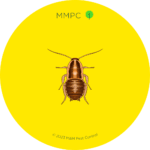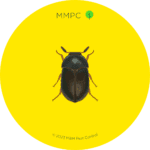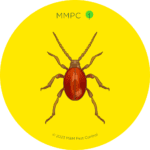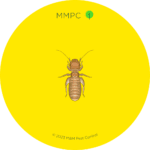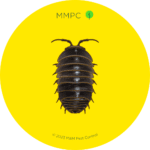
Found an insect in your home that resembles a bed bug?
Bed bugs are notoriously difficult to find and get rid of, and the damage they can cause ranges from itchy bites to psychological distress. But before taking any drastic actions (like this), take a deep breath and carefully check if what you found is really a bed bug.
There are several types of household pests that resemble bed bugs in terms of size, shape, and color. In this article, we’ll introduce the 8 most common household pests that people mistake for bed bugs:
If you ever need help identifying something that looks like a bed bug, send a picture to MMPC’s Free Pest ID Center and our pest experts can help provide identification and treatment recommendations.
What Do Bed Bugs Actually Look Like?
Bed bugs are reddish-brown insects that measure between 1/6–1/4 inches or 4–7 millimeters in length (about the size of a flaxseed or a small apple seed).
An adult bed bug has 6 thin legs and a large, flat, oval-shaped abdomen. After it feeds on blood, the bed bug’s abdomen swells into a long, bloated football shape with a reddish tinge.
In front of the abdomen, bed bugs have a small head and thorax covered by a wide dorsal plate called the pronotum.
The shape of the head and pronotum is a particularly useful diagnostic feature that distinguishes bed bugs from other household pests.

How to Identify a Bed Bug:
- Right behind its head is a unique dorsal plate (the pronotum) with wide, rounded edges that flare out on both sides.
- It’s head has 2 beady eyes protruding on each side.
- It has 2 short, thin antennae made up of 4 segments (called antennomeres).
- In between its antennae, at the very front of its head, is a sort of squared-off protrusion called the rostrum or “beak.” This contains a small tube-like beak called the proboscis, which the bed bug uses to puncture skin and suck blood.
- You should be able to make out faint lines running horizontally across its abdomen, dividing it into 8 sections called sclerites.
Check out our articles on what bed bugs look like and other signs of bed bugs.
Bed Bug Nymphs (Baby Bed Bugs)
A juvenile bed bug, also known as a nymph or instar, looks similar to an adult bed bug except it’s smaller in size and lighter in color.

Bed bug nymphs go through 5 instar stages before reaching adulthood, and between each stage they’ll molt and leave behind a hollow shell casing.
Depending on its stage of growth, bed bug nymphs range in size from 1/16–1/6 inch (1.5–4.5 mm).
In the first instar stage, bed bug nymphs are white and translucent. As they grow and molt, their color gradually darkens from white to yellowish-white to tan to light brown. Their bodies also become less translucent and more of a solid brown color.
Commonly Mistaken for Bed Bugs:
1. Baby Cockroaches
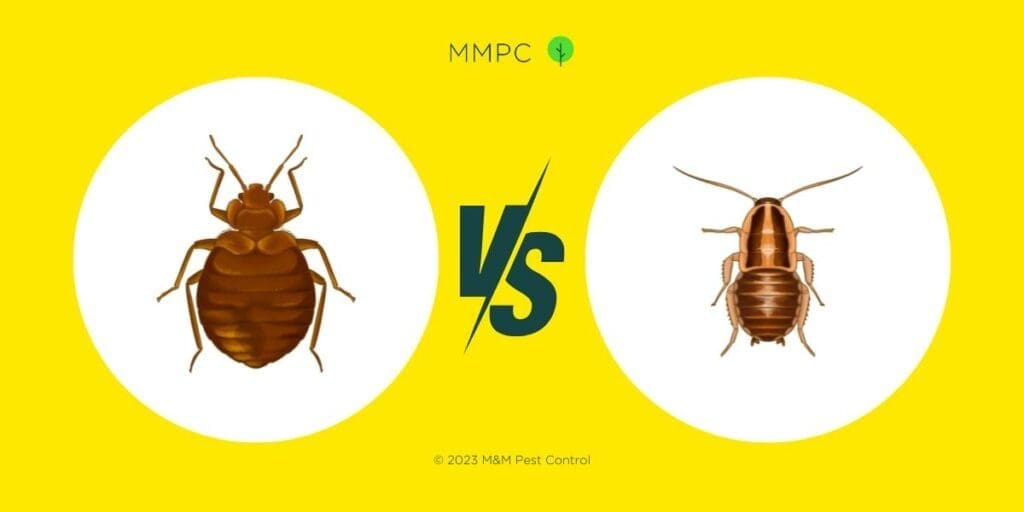
Baby cockroaches, also known as cockroach nymphs, sometimes look surprisingly similar to bed bugs in terms of size and color. Before reaching adulthood, baby cockroaches are small, wingless insects with flat, reddish-brown bodies.
Appearance-wise, the main difference between bed bugs and baby cockroaches is the shape of their bodies and the length of their antennae. Unlike bed bugs, cockroach nymphs have narrow, somewhat pill-shaped bodies and long, thread-like antennae (often longer than their bodies). Bed bugs have wider oval-shaped bodies and short antennae.
Baby cockroaches also have a wide head that’s rounded in the front. They don’t have protruding, squared-off mouthparts between the antennae like bed bugs do.
Lastly, cockroaches also have two stubby appendages called cerci that stick out from the rear of their abdomens, which bed bugs don’t have.
Finding baby cockroach is usually an indication of a pretty serious cockroach infestation. They tend to hide in dark enclosed spaces near areas with food and water. You don’t typically see baby cockroaches in the same places where bed bugs like to congregate (unless you have a habit of leaving food crumbs around your bed).
2. Carpet Beetles
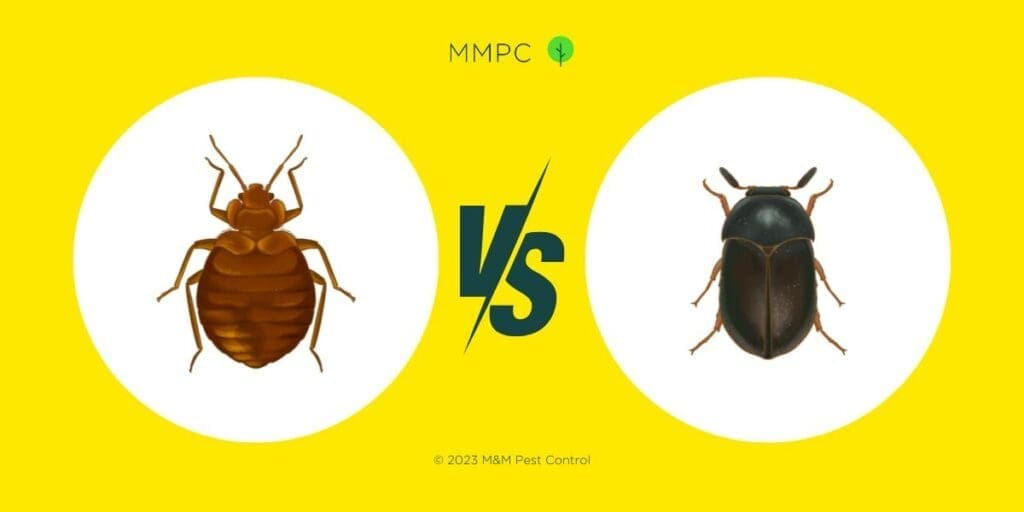
Carpet beetles are another common household pest that look similar to bed bugs. These beetles normally live outside, but they sometimes get into homes and their larvae will feed on carpets, clothing, and other animal-based materials.
In terms of appearance, carpet beetles have large, oval-shaped bodies and small heads. They typically measure around 1/8–3/16 inch long (2–5 mm).
There are a few different species of carpet beetles you might encounter:
- Varied carpet beetles and furniture carpet beetles usually have a mottled pattern of white, brown, and yellow markings covering their body. This makes it easy to distinguish them from bed bugs.
- Black carpet beetles are harder to tell apart from bed bugs because they have a solid brown color and similar oval shape. However, they’re typically more rounded and not as flat as bed bugs, with a hard shell characteristic of beetles.
You can also tell carpet beetles apart from bed bugs by looking at the back of their abdomen. Carpet beetles have two large wing covers, or elytra, that meet at a line going down the middle. Bed bugs don’t have these wing covers, so instead you should be able to see those horizontal sclerites on the back of a bed bug.
Carpet beetles also have shorter antennae than bed bugs. Their antennae appear stubby and have a short club at the ends.
It’s important to note that carpet beetles don’t bite humans or feed on blood like bed bugs do. They are attracted to light and are usually seen near windowsills. It’s unusual to find them around your bed unless it’s right underneath or next to a window.
Carpet beetle larvae look like fuzzy little caterpillars (they’re covered in hairs and bristles called “setae”) and primarily feed on carpets, clothing, and upholstered furniture. These larvae don’t bite people, but prolonged exposure to their setae may cause an allergic reaction called carpet beetle dermatitis.
3. Spider Beetles

Spider beetles are small, bulbous beetles that are usually found in dark places with lots of moisture. They don’t bite and are not dangerous to humans; these insects are scavengers that mainly feed on wool, hair, fabrics, food products, and animal droppings.
These insects have long legs that make them look like a cross between a spider and a beetle. They’re sometimes mistaken for bed bugs because of their large, round abdomens and small heads.
Adult spider beetles are smaller than bed bugs, around 1/16–1/8 inch long (1.5–3.5 mm). They have shiny, rounded bodies that range in color from dark reddish-brown to black. They also have tiny, pale yellow hairs covering their head, thorax, legs, and antennae.
Unlike bed bugs, spider beetles have long antennae that are almost the same length as their bodies. Spider beetles’ abdomens are also small and globular (relative to the length of their legs and antennae), while bed bugs’ abdomens are typically wide and flat.
When a bed bug becomes engorged (after a blood meal), its abdomen becomes elongated and football-shaped, not round and globular like a spider beetle.
4. Fleas

Fleas sometimes get mixed up with bed bugs because both are small, reddish-brown, wingless insects that can leave you with red, itchy bug bites.
Fleas are rather uniquely-shaped because they’re vertically flattened. Bed bugs, and most insects, are flat dorsal-ventrally, which means that they lay flat on their stomachs. Fleas, however, lay flat on their sides. This body structure helps them navigate their way through dense coats of hair like on a dog or a cat.
So if you find a small, dead bug that’s laying on its side, and you can see its legs sort of all on one side, then you can be pretty sure it’s a flea and not a bed bug.
Size-wise, fleas are much smaller than bed bugs. They typically measure only 1/16–1/8 inch long (1.5–3 mm). They also have long, spiny legs, which you don’t see on bed bugs.
5. Ticks
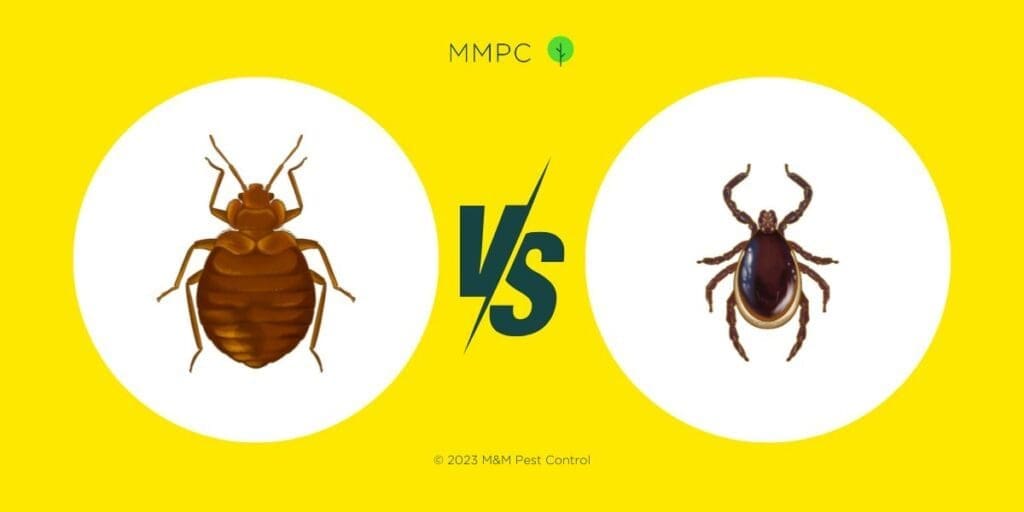
At first glance, ticks and bed bugs seem to share several similar characteristics. Both are small, blood-sucking pests with flat, wingless, oval-shaped bodies.
Prior to feeding, ticks are usually only 1/16–1/5 inch long (1–5 mm), depending on the species. Their bodies become much larger and rounder after a blood meal. However, a fed tick takes on a round, bulbous shape (unlike a bed bug, which takes on an elongated, football shape).
Another distinguishing feature of adult ticks is that they have 8 legs, not 6. That’s because ticks aren’t actually insects—they’re actually arachnids, and are related to spiders and scorpions. Baby ticks actually also have 6 legs (they grow the last pair once they reach adulthood), but they’re way smaller than bed bugs and are about the size of a poppy seed.
You can also tell a tick apart from a bed bug because it doesn’t have that characteristically flared-out pronotum that bed bugs have behind their heads. Ticks also don’t have any visible antennae on their heads, while bed bugs do.
Lastly, it’s important to note that while bed bugs don’t transmit diseases through their bites, ticks do. They are considered vectors for diseases like Lyme and Rocky Mountain Spotted Fever, caused by bacteria, parasites, and viruses transmitted through their bites.
6. Booklice
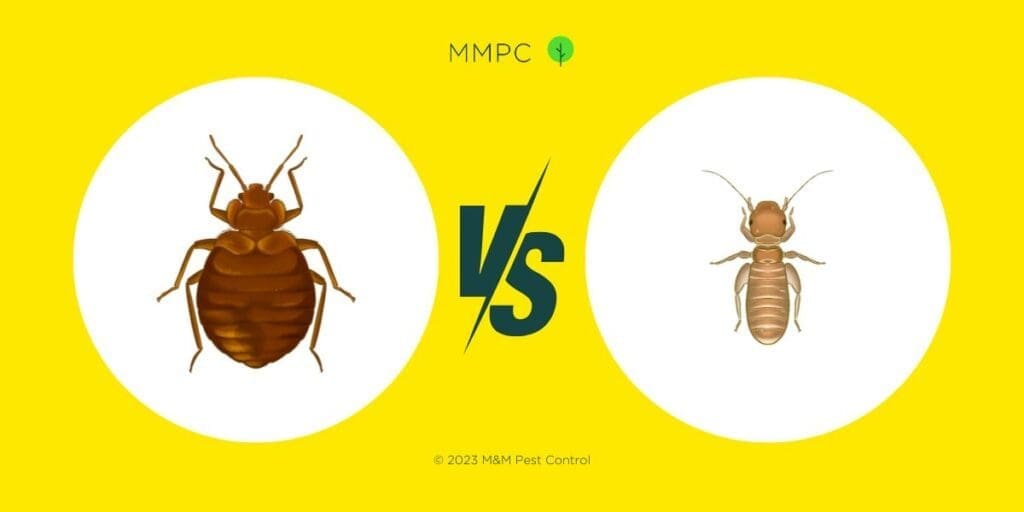
Booklice are pests that are occasionally mistaken for bed bug nymphs. These wingless, soft-bodied pests are typically between 1/25–1/16 inch long (1–2 mm) and whitish-yellow or tan in color.
The main differences between booklice and bed bug nymphs is the shape of their bodies. Booklice have slender, elongated bodies compared to bed bug nymphs, which are rounder and wider. They also have wide heads separated from their abdomens by a narrow thorax. On the other hand, bed bug nymphs have a wide abdomen and a small head separated by a flared pronotum.
If you take a closer look at the head, you can see that booklice have a large and smooth bulge at the front called the clypeus, which is their upper lip. You won’t be able to see the tube-like mouthparts at the front of its head like you would on a bed bug.
Booklice also have long, thin antennae while bed bugs have short, somewhat stiff-looking antennae. Their legs are also longer than a bed bug’s, and the hind pair of legs appears extra thick.
Unlike bed bugs, booklice don’t bite and feed on the blood of humans and animals. If you have booklice, they won’t bite you or threaten the structure of your home. These pests typically nest in undisturbed places with lots of moisture or mold. They also feed on starchy material like the glue in book bindings, which is where they get their name from.
7. Pill Bugs and Sow Bugs

Certain species of pill bugs and sow bugs may appear similar to bed bugs in terms of their size, color, and shape. These dark colored, oval-shaped critters normally live outdoors in damp, shady areas with lots of soil and vegetation, but one might find its way indoors through small cracks or gaps.
Unlike bed bugs, pill bugs and sow bugs aren’t actually insects—they’re crustaceans. Because of this, they have way more legs than a bed bug does (14 in fact, compared to a bed bug’s 6).
Pill bugs and sow bugs have shells made of distinctive plates that allow them to roll up their bodies when threatened. In many sow bugs, these plates have jagged looking edges that you won’t find on a bed bug.
They also have long, thick-looking antennae made up of many segments, while bed bugs have short, thin antennae made up of only 4 segments.
Lastly, sow bugs also have 2 tail-like appendages sticking out from the rear.
1. Bat Bugs

Bat bugs (Cimex pilosellus) are close relatives of bed bugs (Cimex lectularius). Unlike bed bugs, which feed on human blood, bat bugs have evolved to only feed on blood from bats (hence their name).
They typically establish their colonies in places where bats roost, such as in attics, behind walls, and inside chimneys, and only occasionally move into human living areas. Fortunately, this type of pest isn’t known to spread diseases and isn’t considered dangerous.
Appearance-wise, bat bugs are nearly identical to bed bugs. Like bed bugs, bat bugs have small, flat, oval-shaped bodies with 6 legs, 2 antennae, and beak-like mouthparts used for feeding.
The most useful identifying feature is the short, fuzzy hairs covering their bodies (called “setae”). When comparing the two, you’ll also see that bat bugs have longer and denser setae compared to bed bugs. This is especially noticeable around the edges of the bat bug’s pronotum and abdomen.
Bat bugs are also slightly darker in color (usually beige or dark brown) with a slightly pale area around the wing pads.
Need Help Identifying Bed Bugs?
Distinguishing bed bugs from other household pests can be challenging, especially when added on top of an already-stressful situation of finding any insect in your home.
MMPC is a NYC-based pest control company that provides reliable and eco-friendly pest solutions, including NESDCA-certified canine bed bug inspections as well as customized extermination and treatment programs.
If you have any questions, or if you’re still not sure if what you’ve found is a bed bug or not, you can send a picture to MMPC’s Free Pest ID Center and one of our pest experts will help identify it for you and provide treatments recommendations.

